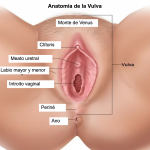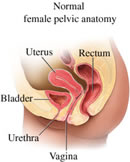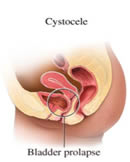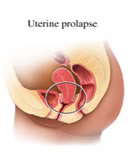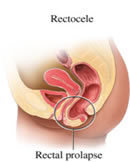Why there is a prolapse?
Prolapse of bladder: or prolapsed anterior (Colpocistocele) refers to the protrusion of the bladder and the vaginal wall to the outside through the front of the vagina.
Rectal prolapse: or prolapse rear (Colporectocele) refers to the protrusion of the bladder and the vaginal wall to the outdoors through the back of the vagina
Uterine prolapse: decline or prolapse of the uterus (Hysterocele) is manifested by the descent of the uterus through the vaginal canal exposing the cervix to the outside.
It is not very often
That symptoms generate prolapses?
The most common symptom refers to the feeling of mass or genital weight which, without being a major pain, can be quite uncomfortable for the patient. He is often described as something that goes "down", a ball, back pain… Occasionally and, in advanced cases, the patient concerned the need to tighten the ball up or down (with the fingers into the vagina) to evacuate the bladder or rectum fully, respectively, since prolapse prevents the full voiding of these organs storage. Another reported symptom is genital bleeding that occurs as a result of the friction of the vaginal wall with the underwear of the patient
How is it measured the degree of severity of the prolapse?
Prolapses are classified based on the closeness or level of protrusion of the vaginal wall or the uterus through the vaginal canal:
Grade 1: small weakness of the wall or little demonstrable uterine descent through clinical trials during a physical examination. The patient feels nothing and only the doctor establishes its presence
The default is hinted to the entrance of the vulva
Grade 4 or prolapse: this level is used to describe the total decline in the uterus through the vaginal canal, accompanied by a cystocele and rectocele grade 3. It is total eversion of the vagina as a glove turned inside out
Can prolapse lead to cancer?
Absolutely not! Unless there has been a prior injury.
What is the treatment?
In advanced cases, corrective surgery vaginally which can range from simple healing of the prolapsed tissue healing of urinary incontinence and anterior and posterior prolapse repair accompanied by hysterectomy is indicated.
Discomfort is minimal and the postoperative period elapses without major constraints.
Prevention
Recommended:
- Controlling chronic constipation.
- Urinating frequently to avoid prolonged bladder distention, which although not shown is a factor of occurrence of prolapse unless prevent you urinary complications for nothing despicable.
Emergence of prolapse
If you have given birth vaginally and/or has the susceptibility gene for developing prolapse is very little you can do to prevent blisters; However, most of them non-surgical, and do not represent a major problem.
